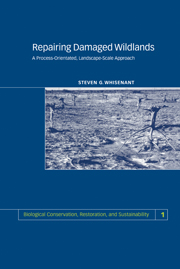Book contents
- Frontmatter
- Contents
- Preface
- Acknowledgments
- 1 Wildland degradation and repair
- 2 Assessing damage to primary processes
- 3 Repairing damaged primary processes
- 4 Directing vegetation change
- 5 Selecting plant materials
- 6 Site preparation and seedbed management
- 7 Planting
- 8 Planning repair programs for wildland landscapes
- Literature cited
- Index
Preface
Published online by Cambridge University Press: 03 December 2009
- Frontmatter
- Contents
- Preface
- Acknowledgments
- 1 Wildland degradation and repair
- 2 Assessing damage to primary processes
- 3 Repairing damaged primary processes
- 4 Directing vegetation change
- 5 Selecting plant materials
- 6 Site preparation and seedbed management
- 7 Planting
- 8 Planning repair programs for wildland landscapes
- Literature cited
- Index
Summary
Ever-increasing demands on wildland ecosystems degrade fundamental resources, reduce species diversity, and lessen the availability of goods and services. Our response to these changes has been constrained by apathy and the very real socioeconomic limitations of wildland ecosystems. Despite great effort and many successes, seriously damaged wildlands are now more abundant than ever. Unrealistic costs, declining benefits, and outright failures have plagued the prevailing paradigms for improving seriously degraded wildlands (or wildlands with low productive potential). The misapplication of otherwise effective agronomic strategies and technologies contributed to these problems.
The outlook supports cautious optimism. Around the world, scientists and practitioners of many disciplines have learned a great deal that is useful for improving damaged wildlands. Although the transfer of this information between countries has improved, communications between disciplines is inadequate. Numerous concepts and practices, with implications for repairing damaged wildlands, are available in the literature of agroforestry, intercropping, soil microbiology, hydrology, ecological engineering, nutrient cycling, mineland reclamation, conservation biology, landscape ecology, and other ecological and applied fields. The abundance of ideas, unique terminology, and differing practices have complicated communication between disciplines at a time when each has much to contribute.
Anyone interested in improving ecological conditions, enhancing biological diversity, or increasing the productivity of damaged wildland ecosystems should find this book useful. I focused on strategies that reduce our dependence on expensive subsidies. Therefore, the approach is to repair processes and initiate natural recovery, rather than replace depleted materials. This deemphasis on replacing materials, like nutrients or basic cations, is not intended to suggest that this approach is not useful in other contexts.
- Type
- Chapter
- Information
- Repairing Damaged WildlandsA Process-Orientated, Landscape-Scale Approach, pp. ix - xPublisher: Cambridge University PressPrint publication year: 1999



